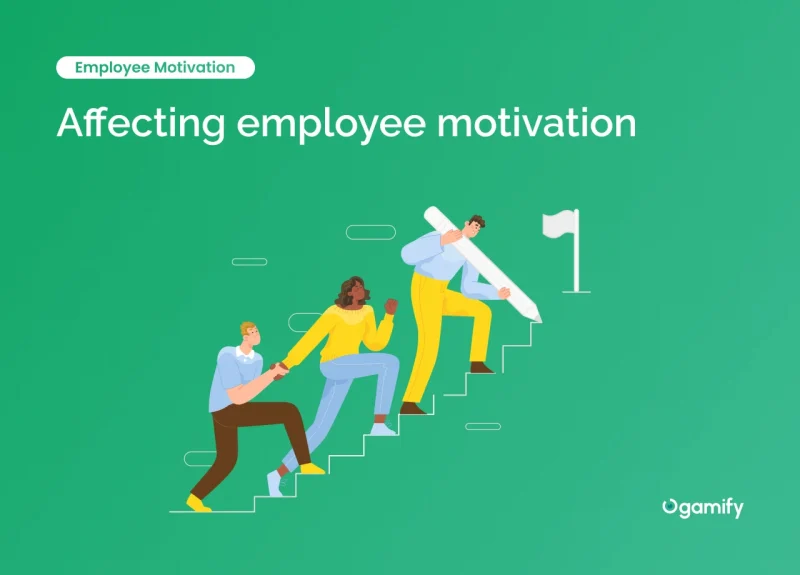Employee motivation is a critical aspect of any organization’s success. Motivated employees tend to be more productive, creative, and committed. However, understanding the factors that affect employee motivation can be challenging, as these can be influenced by various internal, external, organizational, and individual factors.
In this piece, we will delve into the key drivers of employee motivation and what are the factors that influence motivation. By better understanding what are the factors affecting employee motivation, organizations can develop effective strategies to enhance work motivation, leading to increased productivity and success.
What are motivators?

Do you ever find yourself wondering why your motivation is so low? Understanding the top motivators for employees can help shed some light on this question. Motivators are the driving forces that push individuals to take action and achieve their goals, and they can be either internal or external.
Identifying the motivators that drive a person is crucial for anyone who wants to motivate themselves or others and never feel bored at work again. It’s important to recognize that motivators can vary from person to person and even change over time. Some common motivators include financial gain, personal growth, recognition, and a sense of purpose.
However, it’s important to remember that what motivates one person may not motivate another. That’s why it’s essential to have a diverse range of motivators that cater to different individuals. By understanding the biggest influences on employee performance and how they work, you can ensure that you or those around you never feel bored at work again and achieve personal and professional success.
What are the factors affecting employee motivation?
Several types of employee motivation factors influence an level of motivation. A list of motivational factors at work can be broadly categorized into internal and external motivation factors and organizational and individual factors.
Motivation based on internal factors includes an employee’s personal beliefs, values, attitudes, and goals. These motivational factors are intrinsic and stem from within the individual. They are influenced by an employee’s personality, character, and self-esteem. On the other hand, employee motivation can be controlled by external factors, referring to factors outside an employee’s control, such as the work environment, pay, and benefits.
Organizational motivating factors include the company’s culture, management style, leadership, and policies. These factors can significantly impact employee motivation and engagement. A positive work culture encouraging teamwork, communication, and collaboration can boost motivation. Individual factors refer to an employee’s unique characteristics, such as skillsets, experience, and career goals. Employees who feel valued and recognized for their contributions are more likely to be motivated and engaged.
Internal factors affecting employee motivation

Internal factors of motivation are the personal and psychological factors that motivate a person to perform better in their job. These incentives based on internal factors are usually intrinsic motivations and originate from within the individual. There are several examples of internal motivation factors for employees.
One of the most significant motivational factors for employees is a sense of purpose or meaning in work. Employees who feel their work is meaningful and contributes to a greater cause are more likely to be motivated and engaged. Another internal factor is a sense of accomplishment. Employees who feel they are progressing and achieving their goals are more likely to be motivated and satisfied with their work.
Autonomy and control over work processes are other examples of internal motivation factors. When employees have a say in their work performance and are given control over their work processes, there is a higher probability that they will be motivated and invested in their work. Additionally, the desire for personal growth and development is a crucial internal motivation factor. Employees given opportunities to learn and develop their skills are more likely to be motivated and satisfied with their work.
Finally, the need for recognition and appreciation is another internal motivation factor that can influence employee performance. Employees who feel valued and appreciated for their work are more likely to be motivated and engaged. These internal factors are critical in motivating employees and enhancing their job satisfaction. Organizations must consider these factors while designing their HR policies and strategies to keep their employees motivated and invested in their success.
External factors affecting employee motivation

Motivation is a crucial element in any workplace. The driving force makes employees work hard and achieve their goals. While motivation is often considered an internal factor, it can also be controlled by external factors of motivation.
The workplace environment plays a significant role in employee motivation. A clean and organized workspace can help employees feel more comfortable and productive, while a cluttered or noisy environment can be distracting and demotivating. Similarly, the company’s culture can also impact motivation. A positive and supportive culture can encourage employee productivity and commitment to their jobs. In contrast, a negative or toxic culture can lead to demotivation, what motivates employees to work, and turnover.
Finally, the leadership style can also affect employee motivation. A supportive and empathetic leader who recognizes employees’ efforts and provides positive feedback and guidance can inspire them to work harder and achieve their goals. Conversely, a boss who micromanages or criticizes employees can create a demotivating environment that can harm employee morale and productivity.
Organizational factors affecting employee motivation

Organizational factors motivation play a crucial role in factors affecting motivation. Communication is one such factor that can either positively or negatively impact employee motivation. Effective communication channels within an organization can lead to better clarity, understanding of goals, and employee engagement. On the other hand, poor communication can cause confusion, misunderstandings, and low morale among employees.
Organizational structure and design also have a significant impact on employee motivation. The structure of an organization can either empower or hinder employees’ ability to make decisions, take ownership, and contribute to the company’s success. A structured and well-designed organization provides clear roles and responsibilities, a sense of direction, and growth opportunities, which can motivate employees to work.
Job design and workload are another organizational factor that can impact employee motivation. A well-designed job can give employees autonomy, skill variety, and personal growth and learning opportunities, leading to higher motivation. In contrast, a poorly designed job with an excessive workload can cause burnout, stress, and low employee motivation.
Performance management systems are crucial in providing feedback, recognition, and rewards to employees, thus affecting their motivation levels. A fair and transparent performance management system can motivate employees to perform better, achieve their goals, and contribute to the organization’s success. However, a poorly designed performance human resource management system can lead to demotivation, disincentivizing employees from performing at their best.
Individual factors affecting employee motivation

Employee motivation is a crucial aspect of any organization’s success. But how do individual factors affect motivation? It is affected by including personality and individual differences, life events and personal circumstances, as well as work attitudes and perceptions. These factors can significantly impact an employee’s motivation levels and, ultimately, their job performance.
Personality and individual differences play a significant role in how individual factors are influencing motivation. People have different personalities, interests, and preferences, which can influence how they respond to different work situations. For instance, some employees may be more motivated by challenges and opportunities for growth, while others may be more motivated by financial incentives or flexible work arrangements. Life events and personal circumstances can also profoundly impact employee motivation.
Finally, work attitudes and perceptions can significantly affect employee motivation. Employees who feel valued and respected by their employers are more likely to be motivated to perform at their best.
Similarly, employees who feel their work is meaningful and contributes to the organization’s overall goals are more likely to be motivated and engaged. In conclusion, individual factors can significantly impact employee motivation levels. Employers must be aware of these factors and provide the necessary support and resources to help employees stay motivated and engaged.
Conclusion
Employee motivation is essential for any organization to achieve success. Understanding what motivates employees the most is crucial to developing effective strategies to amplify your incentive and increase productivity.
Several internal, external, organizational, and individual factors influence employee motivation. These include a sense of purpose, sense of accomplishment, autonomy, personal growth, recognition, workplace environment, culture, leadership, communication, organizational structure, and job design.
You can help yourselves or your employees improve all those types of incentives by using tools for efficiency.
A positive and supportive work culture, effective communication channels, well-designed jobs, and opportunities for personal growth are critical in enhancing employee motivation. Organizations that consider these factors will likely have a highly motivated workforce committed to their success.
FAQ
Are financial incentives the only effective way to motivate employees?
While financial incentives can be a motivating factor, they are not the only effective means of motivating employees. Recognition, opportunities for growth, a positive work environment, and meaningful work are equally important in fostering employee motivation.
How can organizations measure employee motivation levels?
Employee motivation can be measured through surveys, feedback sessions, and performance evaluations. Organizations can also track indicators such as employee turnover rates, productivity levels, and employee satisfaction to gauge the overall motivation within the workforce.
What should organizations do if they notice low motivation among employees?
If organizations observe low motivation levels among employees, it is essential to identify the underlying causes. Conducting employee surveys, engaging in open dialogue, and addressing any concerns or challenges can help organizations take appropriate measures to improve motivation, such as implementing new recognition programs or providing additional training opportunities.
Can individual employees take steps to improve their own motivation?
Yes, individual employees can take proactive steps to enhance their own motivation. This includes setting personal goals, seeking opportunities for growth, and maintaining a positive mindset. Seeking support from supervisors, colleagues, or mentors can also contribute to increased motivation.
How can organizations sustain employee motivation in the long term?
Sustaining employee motivation requires continuous effort and commitment from organizations. This includes consistently providing recognition, creating development opportunities, fostering a positive work environment, and adapting to changing employee needs. Regular communication, feedback, and evaluation processes can also help organizations maintain high levels of employee motivation.


